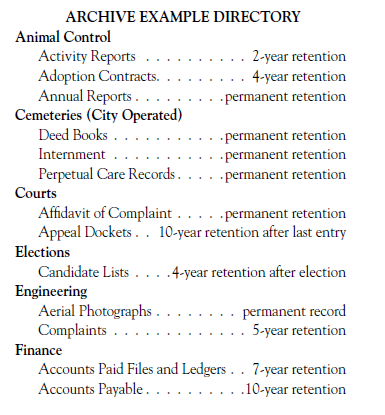Archival Policy for Electronic Information
This section is intended to provide guidance, especially to smaller cities, in the creation and implementation of a practical and cost-effective archiving policy for Electronically Stored Information (ESI). Various state and federal laws require cities to retain certain records and communications for differing amounts of time. The fact that such a document is in an electronic format in no way relieves such responsibility. In fact, amendments to the Federal Rules of Civil Procedure clearly stipulate that special procedures must be taken to protect electronic data. To ensure compliance with state and federal laws, every city should institute an ESI archiving policy, which at a minimum:
- Determines whether manual or automatic archiving is preferable for the retention of ESI;
- Appoints someone to oversee and ensure compliance with this policy; and
- Ensures that the retention archives are consistent throughout the organization so that retrieval, when necessary, can be timely and thorough.
A well-reasoned and thoughtfully implemented retention policy conveys an image of transparency, which is a benefit to any city. Such a policy can also save large amounts of time and money in the context of a discovery request. A policy for ESI retention should exist in conjunction with a more exhaustive records retention schedule.
The Records Management for Municipal Government section in this database provides a nearly comprehensive list of municipal records and the appropriate retention period for each class of records. Many of these classifications of records such as warrants and other court documents may not exist in electronic format. Other records however, such as employment correspondence, citizen complaints, and other vital information, are becoming increasingly common in an electronic form. The overriding principle here is that record retention is subject-based not medium-based. Hence a letter and an e-mail with the same content would require the same retention.
When managing your ESI, there are two basic archiving methods – automatic and manual. Deciding which method will suit the needs of your city is the first step in developing a sound ESI retention policy. Generally, automatic archiving systems are preferable for large organizations that generate large volumes of ESI. While these systems are very thorough, their expense may be cost-prohibitive to many cities. Despite its potential for human error, manual archiving will be the likely choice for most Tennessee cities.
The first method, automatic archiving, is an automated system that would be managed by your IT department. Many such systems, available through various vendors, will harvest, archive and delete your ESI based on the rules that are implemented in the software. The rules that you implement are established by your written policy. A list of a few of the products and vendors is included at the end of this page. The recommendation of a specific software product is outside the scope of this document.
The second method, manual archiving, is a manual process managed by the individual users in your municipality. This method is similar to the current approach with paper documents and can even mirror this process if you decide to print all ESI and file it away with your other documents. Each user would be responsible for all the ESI that is created and received by that user. However, the municipality has the responsibility of developing, training, maintaining and auditing this method. If you would like to maintain your ESI in electronic format, consult with your IT department because your capability to do so depends on the server resources and technologies available to you. Manual archiving will work even if you do not have an IT department or a server. One example of this method would be to create a filing structure that would mirror the subject guidelines established in the Records Management for Municipal Governments - Retention Schedules. See figure below.

This structure can be established in your e-mail file, a file server drive, or on the system drive for your specific computer. Note that if you are keeping this data electronically for retention purposes, keep it in a location that is backed up to another form of media on a regular basis. In the example shown above, the retention period was added to the name of the folder to make management of the content easier for the user.
Finally, it is important to note the distinction between ESI archiving and the use of backup software. While archiving makes content distinctions and saves ESI accordingly, backup software stores all ESI transmitted during a specified time frame. Backups can be very large, unwieldy databases, and due to technological limitations in retrieval, would not satisfy the requirements of an archive system. Backup systems are designed for disaster recovery situations – not record retention.
Make sure your city has an adequate archival system for its ESI. Waiting until you receive a Subpoena Duces Tecum will certainly be too late.
